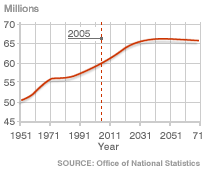 Project Britain
Project Britain
British Life and Culture
by Mandy Barrow
- Search our Site
- Project Britain
- Calendars
- Facts and figures
- London
- Great Britain
- Union Flag
- A-Z of Britain
- Customs & traditions
- Britain today
- Daily Life
- Money
- Etiquette
- Monarchy
- Government
- Education
- Tourist Information
- Food and drink
- Sports and leisure
- History
- Kings and Queens
- Superstitions
- Glossary
|
What is the population of Britain?
|
||||||||||||||||||||||||||||||||||||||||||||||||||||||||||||||||||||||
|
Do you mean Great Britain or the United Kingdom?
Many people confuse the two. Great Britain (Britain) is made up of England, Scotland and Wales, whereas the UK is Britain as well as Northern Ireland. ( Find out more about the difference here)
A census of the population in Britain has been taken every 10 years since 1801 (with the exception of 1941, when Britain was at war). The next census will be in 2011. 2001 Census In 2001, the population of the United Kingdom was recorded at just under 59 million people. Great Britain is heavily populated compared with many other countries. Britain is a relatively densely populated country: it is more than twice as densely populated as France (106 people per sq.km), nine times as densely populated as the USA (27 people per sq.km) and 100 times as densely populated as Australia (2 people per sq.km). Britain ranks 18th in the world in terms of population size. The population is very unequally distributed over the four parts of the UK:
Source: Office for National Statistics; National Assembly for Wales; General Register Office for Scotland; Northern Ireland Statistics and Research Agency (updated Jan 2008) The population of the United Kingdom was estimated to be 60,975,000 in mid-2007, up by 388,000 (0.6 per cent) on the previous year and nearly two million more than in mid-2001.
From the table above you can see that England has the highest population density and Scotland the lowest. This is mainly due to many parts of Scotland being unsuitable for people to live. Nearly 84 per cent of the total population of the United Kingdom lives in England. The most densely populated areas of England are the major cities and metropolitan areas of London and the South East, South and West Yorkshire, Greater Manchester and Merseyside, the West Midlands, and the conurbations on the rivers Tyne,Wear and Tees. London has the highest population density with 4,00 people per square kilometre, and the South West the lowest (210 people per square kilometre). England is by far the most densely populated part of the UK. In 2003, it had a population density of 383 people per sq km compared with Wales (142), Northern Ireland (125) and Scotland (65). London had a far higher population density than any of the English regions, with 4,700 people living in each square kilometre on average. England's population density is more than treble the European average of 117 people per sq km. England is also one of the most densely populated countries in the world. Source: Office for National Statistics; National Assembly for Wales; General Register Office for Scotland; Northern Ireland Statistics and Research Agency Resident Population For the first time ever, the UK has more people aged over 60 than under 16. Today there are five times more people aged over 85 than there were in 1951.
2005
The UK population increased by 7.0 per cent since 1971, from 55.9 million. Growth has been faster in more recent years partly as a result of a greater number of births than deaths, with migration an increasing factor from the late 1990s. . Between mid-1991 and mid-2003 the population grew by an annual rate of 0.3 per cent. Source: Office for National Statistics; National Assembly for Wales; General Register Office for Scotland; Northern Ireland Statistics and Research Agency
|
||||||||||||||||||||||||||||||||||||||||||||||||||||||||||||||||||||||
 © Copyright - please read © Copyright - please read All the materials on these pages are free for homework and classroom use only. You may not redistribute, sell or place the content of this page on any other website or blog without written permission from the Mandy Barrow. |
© Copyright Mandy Barrow 2014
Mandy is the creator of the Woodlands Resources section of the Woodlands Junior website.
The two websites projectbritain.com and primaryhomeworkhelp.co.uk are the new homes for the Woodlands Resources.
Mandy left Woodlands in 2003 to work in Kent schools as an ICT Consultant.
She now teaches computers at The Granville School and St. John's Primary School in Sevenoaks Kent.
Woodlands Junior Homework Help new website

 In mid-2005 the UK was home to 60.2 million people, of which 50.4 million lived in England. The average age was 38.8 years, an increase on 1971 when it was 34.1 years. In mid-2005 approximately one in five people in the UK were aged under 16 and one in six people were aged 65 or over.
In mid-2005 the UK was home to 60.2 million people, of which 50.4 million lived in England. The average age was 38.8 years, an increase on 1971 when it was 34.1 years. In mid-2005 approximately one in five people in the UK were aged under 16 and one in six people were aged 65 or over.